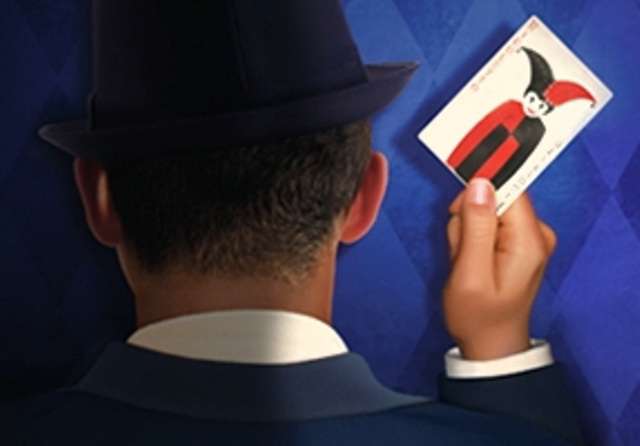|
Back
Rigoletto the Il Duce Way Cincinnati
Music Hall
06/16/2011 - & June 18, 2011
Giuseppe Verdi: Rigoletto
Rodrick Dixon (Duke of Mantua), Wesley Lawrence (Borsa), Jacqueline Echols (Countess Ceprano), Stephen Powell (Rigoletto), Tyler Alessi (Marullo), Timothy Bruno (Count Ceprano), Nathan Stark (Monterone), Gustav Andreassen (Sparafucile), Sarah Coburn (Gilda), Davia Bandy (Giovanna), Alisa Suzanne Jordheim (page), Noel Bouley (usher), Stacey Rishoi (Maddalena)
Cincinnati Opera Chorus (Henri Venanzi, Chorus Master), Cincinnati Symphony Orchestra, Jean-Marie Zeitouni (Conductor)
Linda Brovsky (Stage Director), Robert Dahlstrom (Scenic Designer), Marie Anne Chiment (Costume Designer), Thomas Hase (Lighting Designer)

(Courtesy of Cincinnati Opera)
Verdi’s Rigoletto has been fodder for Cincinnati Opera since its premiere in the company’s inaugural season in 1920. In fact, the production of Rigoletto June 16 at Music Hall to open its 2011 summer festival marked the 122nd performance of Rigoletto in Cincinnati Opera history (repeat is June 18). It was a return of the Seattle Opera production presented in 2005, Cincinnati Opera’s last outing of Rigoletto. Music Hall’s 3,400 seats (not counting obstructed views, which add about 100) were three-quarters filled.
The setting has been updated from 16th century Mantua to the Mussolini era. It is 1936 and the Duke of Mantua holds sway with fascist thugs. Rigoletto, originally the Duke’s court jester, is a lowly employee, who both mops the floor and amuses the Duke with his sharp tongue. The concept, by director Linda Brovsky with set design by Robert Dahlstrom and costumes by Marie Anne Chiment, works largely by virtue of Italy’s museum aspect and the universality of the characters. There is the Duke, the remorseless sexual predator with power and apathy on his side, the innocent girl (Gilda) whose love is pure and sacrificial, and the loving but over-protective father (Rigoletto). The Duke’s palace includes the monumental sculpture, Pluto and Proserpina, by Bernini, a mural of the Trojan War and a painting of the Duke in modern style, creating an across-the-centuries look.
Singing Rigoletto was baritone Stephen Powell, with soprano Sarah Coburn as Gilda and tenor Rodrick Dixon as the Duke. It was Dixon’s company debut. As a trio, they presented some of the finest characterizations seen and heard at Cincinnati Opera in recent seasons. Adding fuel to the roiling emotions were bass Gustav Andreassen as the assassin Sparafucile, mezzo-soprano Stacey Rishoi as his complicit sister Maddalena, and bass Nathan Stark as Count Monterone, the outraged father who voices the fatal curse. Conductor Jean-Marie Zeitouni led the Cincinnati Symphony Orchestra with great skill.
Act one, set during Carnival in Mantua, found ladies in satin gowns, men at billiards and the Duke ogling the Countess of Ceprano while singing “Questa o quella,” “this one (girl) or that.” Rigoletto in a jester’s hat makes fun of her jealous husband, but goes too far – not that the Duke hasn’t warned him -- when Monterone bursts in to protest the Duke’s ravaging of his daughter. Rigoletto’s cruel taunting -- with Powell atop the billiard table -- invokes the curse. In a brutal but effective display of human vice -- exacerbated by Monterone’s depiction as a Jew -- Stark was pistol-whipped as fireworks (streams of confetti) burst across the sky.
The worried, vulnerable Rigoletto emerged as he trudged home to his daughter. Powell and Coburn exemplified the tenderness of filial love, as Rigoletto expresses concern for Gilda’s safety and she prods him for details about her mother (deceased) and what Rigoletto does for a living. Dixon poured on the romance during the Duke’s visit to Gilda in the guise of the poor student who has been eying her at church. Their parting “addios” were feverish in the extreme. Coburn’s “Caro nome,” as Gilda ponders his (fake) name, was kittenish and sweet, with excellent placement of the voice, trills and all.
Act two saw Dixon attempting to soften the Duke’s image, musing about Gilda’s sincere love and how it almost prods him to “virtue.” The sentiment was undercut, however, by a flagrant high note as he rushed offstage to “console” Gilda, having learned she has been kidnapped and brought to his palace. Powell set his seal upon the opera with Rigoletto’s heart-rending pleas for the release of Gilda and his determination both to comfort and avenge her (sung ironically, at the base of the statue of Pluto carrying off Proserpina).
Act three at Sparafucile’s inn gave Dixon a further opportunity to play the agile seducer. The opera’s best known aria, “La donna è mobile,” was delivered with facility and charm, and he peeled off Maddalena’s stockings expertly. The famous quartet (Rigoletto, Gilda, Sparafucile and Maddalena) was a musical and psychological highpoint.
The denouement, Gilda’s sacrifice (significantly, it is Good Friday), took place amid a very realistic, strobe-lit storm. Andreassen delivered the knife thrust originally meant for the Duke, and he and Rishoi wrapped Gilda’s body in canvas. Powell voiced the tragedy in heart-rending fashion when he discovered what the audience already knew: Monterone’s curse has taken his daughter.
Cincinnati Opera
Mary Ellyn Hutton
|